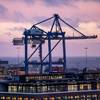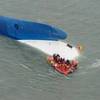Elements of the USS Nassau (LHA 4) Expeditionary Strike Group (ESG) including the dock landing ship USS Carter Hall (LSD 50), amphibious transport dock USS Austin (LPD 40) and the guided-missile cruiser USS Cape St. George (CG 71), carrying more than 2,700 Sailors, returned to Naval Station Norfolk and Naval Amphibious Base Little Creek May 4, following a six-month deployment is support of the global war on terrorism.
Nassau ESG ships, which deployed Nov. 7, conducted maritime security operations in the U.S. 5th Fleet area of responsibility (AOR) and supported theater security cooperation in the U.S. 6th Fleet AOR.
Other members of the ESG, including the guided-missile destroyer USS Winston S. Churchill (DDG 81), returned May 2. The guided-missile destroyer USS Arleigh Burke (DDG 51) and attack submarine USS Norfolk (SSN 714) are due home May 7.
“The whole ESG was well trained for this deployment,” said Commander, Amphibious Squadron 6, Capt. Martin Allard. “All 2,700 personnel throughout the strike group received full integrated strike group training for non-combatant operations,” said Allard.
While deployed, Cape St. George and Austin maintained security for Iraqi oil platforms in the Northern Persian Gulf while working closely with mobile security detachments, coalition forces and the Iraqi navy.
Carter Hall became the air cushion landing craft (LCAC) ship for the Nassau ESG, where they offloaded the 22nd Marine Expeditionary Unit (Special Operations Capable) (MEU(SOC))at Kuwait Naval Base.
Shortly after this offload, the strike group participated in an anti-piracy operation in the Indian Ocean.
“We liberated a crew of 16 people who were on an Indian small-trade ship,” said Allard. "This took place for three months.”
Carter Hall also conducted an underway replenishment training exercise with the French frigate Courbet, where French and American Sailors conducted a cross-deck swap. Ships in the Nassau ESG participated in several training exercises with coalition forces in the area.
In the North Persian Gulf, they worked closely with British and Australian ships, while the ships in the Arabian Sea and Indian Ocean operated with the French, German and Dutch navies as part of Coalition Task Force 150.
In February, Carter Hall and Nassau began transiting north to the Persian Gulf, where they offloaded the 22nd MEU(SOC). After the offload, Carter Hall transited to Kuwait Naval Base to backload the Marines.
While operating under CTF 150, the strike group remained in the Persian Gulf to conduct maritime surveillance operations as part of Operation Sea Dragon III.
Nassau, Austin and the 22nd MEU(SOC) conducted a final exercise with Djibouti before heading out of the 5th Fleet AOR. The exercise offered the opportunity for Marines from the MEU to conduct bilateral training, while the Aviation Combat Element practiced low-altitude training and fire-support functions.
“Throughout our deployment, we conducted maritime security operations, which are designed to keep sealine security operations open and safe,” said Allard. “We also conducted bilateral exercises.”
Allard said this deployment was a great success for his crew, and they were able to support every mission required of Nassau ESG.
“The entire strike group did an outstanding job in accomplishing every mission assigned,” said Allard. “By practicing safety, we are able to bring home every Sailor we departed with.”
Source: NavNews
By Journalist 2nd Class Maja A. Dyson, Fleet Public Affairs Center Atlantic
Sponsored Content
Chris-Marine’s solutions help to prolong engine lifetime

AST is now AST Networks, bringing you remote connectivity wherever you are

March 2024
 Read the Magazine
Read the Magazine

 Read the Magazine
Read the Magazine
This issue sponsored by:

America’s Watershed Initiative: Sustaining a Critical Waterway
Subscribe for
Maritime Reporter E-News
Maritime Reporter E-News is the maritime industry's largest circulation and most authoritative ENews Service, delivered to your Email five times per week












